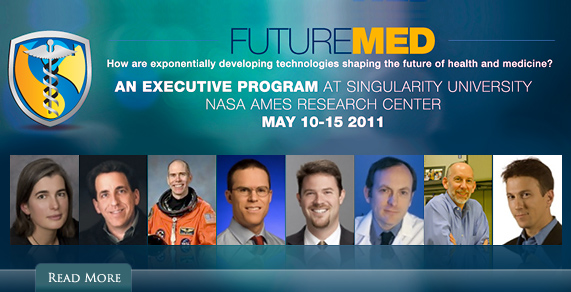FutureMed at Singularity University
February 13, 2011
FutureMed at Singularity University | Exploring and driving the future of medicine through exponential, game-changing technologies.
How will rapidly developing technologies such as the low cost genomic sequencing, artificial intelligence, telemedicine, robotics, 24/7 body wearable monitors, smart pills, stem cells, synthetic biology, gene therapy, and crowd sourced health data affect the future of healthcare and medicine?
FutureMed represents the cutting edge of thinking regarding the future of medicine, questioning the implications and potentials of technology bringing together a unique interdisciplinary mix of faculty and participants to examine the intersection of exponential technologies and their potential to transform all aspects of healthcare over the next 5-15 years.
In this 5-day immersive program held at Singularity University on the NASA-Ames Research Park in the heart of Silicon Valley Gain an over-the-horizon radar perspective and experience in what is emerging in the lab and clinic today, and where opportunities in medicine are moving through disruptive, convergent and rapidly developing technologies.
WHO SHOULD ATTEND:
Physicians (CME credit offered), Bio-MedTech & Pharma Executives, Health-Focused Innovators, Inventors & Entrepreneurs
CORE TRACKS INCLUDE THE FUTURE OF:
Data & Network Driven Healthcare, Genomics & Personalized Medicine, Regenerative Medicine, Neuromedicine, Intervention, Biotech Innovation, Medical Practice
WORKSHOPS TO INCLUDE:
Quantified Self/Wearable Devices, Synthetic Biology, Innovation and Invention, Future of Drug Development
SITE VISITS TO INCLUDE:
Google Health, NASA Life Sciences
Stanford Medical School, Intuitive Surgical, Kaiser Innovation Center, Autodesk Innovation Labs
FutureMed at Singularity University focuses on exponential technologies which will revolutionize the practice of medicine, and transform healthcare and the biomedical industry in the decade ahead. The FutureMed program is designed for physicians (CME Credit is provided), medical executives, investors and entrepreneurs who are interested in understanding the powerful, convergent forces being introduced into the medical arena by technologies such as low cost genomic sequencing, the digitization of health data, medical robotics, artificial intelligence, nanomaterials, stem cell technology, systems medicine, bioinformatics, and synthetic biology.
Through a series of speakers, panels, hands on experiences, site visits, in-depth workshops, and late night discussions, participants will gain an over-the-horizon perspective, and complete the intensive program with new relationships, insights into unmet needs, trends, novel therapeutic modalities, business concepts, and collaborations that will transform the world of healthcare, from wellness and prevention to diagnosis and therapy.
FutureMed Questions | The Future of Medicine and Exponential Technology
- The cost and speed of human genome sequencing is dropping at more than a double-exponential rate, down from millions to $10,000 in cost today. What do we do when ubiquitous $100 or even free genomes become available? How do we leverage, crowdsource and make this immense and complex information actionable within healthcare?
- How will the convergence of ubiquitous mobile devices and real-time patient health monitoring change the patient-physician relationship and transform the future of medical practice?
- Imaging technology and information is ramping up dramatically: The rapid CT scans of yesterday produced 100 slices (50MB of data), today they produce 24K slices (20GB), and soon there will be Terabyte (800K phonebooks) datasets acquired in seconds: how will we manage and leverage this degree of information?
- Point of Care Diagnostics will dramatically change with the advent of point of care microfluidics and genomics, enabling immense diagnostic power at a low price point and within the clinic. What do we do with a proteomic fingerprint of thousands of biomarkers, from impacting early disease detection to managing and modifying therapy?
- Google has developed an autonomous robotic car able to safely drive hundreds of thousands of miles. As robotic and sensor technology continues to evolve, will similar autonomous systems take the surgeon out of the loop?
- How will various modalities from virtual reality displays and brain computer interfaces enhance the capabilities of clinicians ranging from radiologists to neurosurgeons?
- In 1999 the first human embryonic stem cell line was developed. A decade later the 1st clinical trials are underway utilizing off the shelf oligodendrocytes derived from embryonic stem cells. Regenerative medicine is on the cusp of being cellular ‘alchemy,’ reprogramming directly from skin cells to neurons and cardiomyocytes in the lab. How will such technologies enable regenerative medicine and the repair and replacement of tissues and organs damaged by aging, trauma and disease?
- Gene therapy, derailed in decades past, is now in resurgence with the development of targeted gene therapy approaches which enable specific genes to be safely replaced. What new paradigms of prevention and therapy will emerge when genetic modification can be done in a safe, targeted, outpatient modality?
- Personalized medicine attempts to tackle the long tail of medicine…targeted, patient specific therapies instead of one sized fits all. Recognizing that almost every cancer is unique, how will multiple exponential technologies, from genomics and expression gene profiling, to proteomics, methylation and detection of rare circulating tumor cells change the face of oncology and individualized cancer regimens?
- How will regulatory bodies respond to n=1 clinical trials?
- Healthcare information is rapidly becoming digitized. Convergent technologies connecting patients and physicians in real-time are rapidly evolving and integrating. Clinicians will be able to practice medicine from virtually anywhere at anytime, with instant access to the information and systems they need. What is the likely timing, barriers and opportunities in the evolving arena of digital medicine?
- Medical devices and implants (such as pacemakers) continue to shrink in size at exponential rates, and grow in terms of capabilities and level of integrated technology. What will the future of minimally invasive devices and implants look like? What unmet needs can they address?
